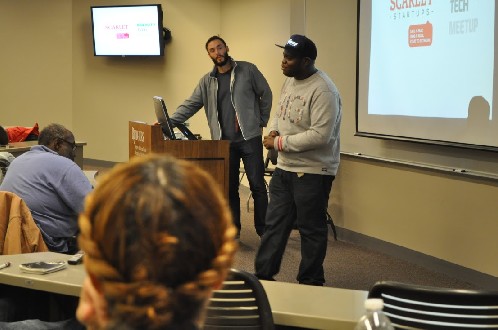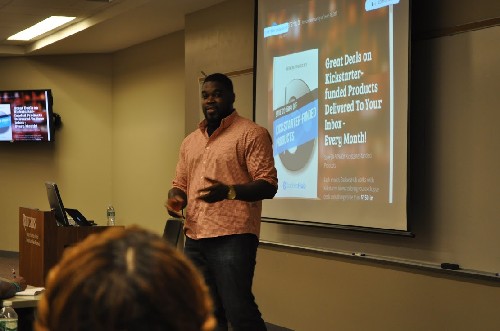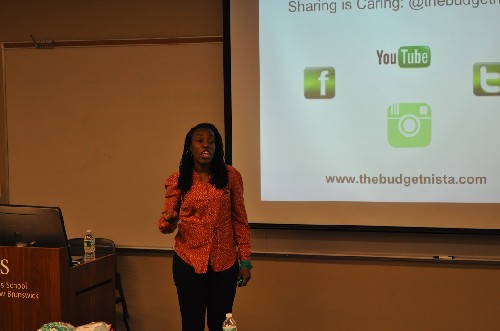Speakers Talk Turning Followers into Customers during Joint BrickCity Tech, Scarlet Startup Workshop

How does a business get followers on social media? How does that business turn those followers into customers? And how does an entrepreneur who’s down in the dumps pull herself up and start the next big thing?
These are just some of the questions that Dwight Peters, of BackersHub, and Tiffany Aliche, the “Budgetnista,” answered during a joint BrickCity Tech/ Scarlet Startup Meetupworkshop on Nov. 3 at Rutgers Business School, in Newark.
Peters, a recent transplant from New York to New Jersey, spoke first, telling the audience how he had gone to Silicon Valley a year ago to try to build a business. “I didn’t have any idea what I was doing,” he said. “I didn’t have any real structure planned. I just knew that I had to get out of my comfort zone as an entrepreneur.”

He slept on a friend’s couch, and after three months he ran out of money. That’s when he got the idea for BackersHub, which matchesKickstarter donors with interesting crowdfunding campaigns.
“It’s funny. When you’re in that position, when your back is to the wall, that’s when that survival mechanism just kicks in and your brain starts to work differently,” Peters said.
Peters used Lean concepts like customer development to hone his idea. He talked to campaign creators who wanted to know how they could get a meaningful number of backers besides say, their mom and dad, best friend, and third grade teacher.
“They kept saying the same thing over and over again, about ‘my number one concern is how to get backers’,” he said. “I said we could do it. I didn’t how we were going to do it, but if a lot of people were asking, then I thought this is something that we need to focus on.”
He also found that 60 percent of Kickstarter funding comes from serial backers who are looking for a good deal, even if they don’t personally know the creator of a campaign. Most of the subscribers to BackersHub have funded dozens of campaigns, and some have even funded hundreds.
Peters gets revenue by promoting campaigns to his subscriber list of interested donors. Subscribers pay to learn about new deals and to get other exclusive access. He also sells promotional services to campaign creators, who then steer new donors to the subscriber list, a benefit Peters called a “high-level mouse trap.”
Giving advice about growing a community of followers, Peters mentioned that he has relied on word-of-mouth among Kickstarter donors and campaign creators more than on formal advertising.
“Get in front of the gatekeepers,” he said. “There’s somebody that has access to your community. We get the gatekeepers to tell our desired audience about us.”
“It’s not hard building a community,” he added. “You need to find your niche. Build something that other people are passionate about. If you can find ten people, you can find a hundred. If you can find 500, you can find 10,000.”

Like Peters, Tiffany Aliche rescued herself from a difficult situation. By age 25 she had a career as a preschool teacher, and had even bought a house. But when the recession hit, she lost her job and had to move back in with her parents.
As she was unemployed and had time, she started volunteering, teaching financial literacy classes for nonprofits and other organizations. Her father had been a CFO, and he had regularly given the Aliche children lessons in managing money.
Aliche said, “I didn’t think it was a business. After a few months, my best friend said turn it into a business. I said ‘can you charge for that?’ I had no idea. So I started to charge.”
When she was a preschool teacher, Aliche would teach the kids’ parents money management during naptime, writing out the lessons in a notebook. She got the idea to revise her notes into a book, The One Week Budget. When she was only able to self-publish, and could only interest friends and family in the book, she realized that she needed to expand her community of potential customers.
She began mixing with Newark’s entrepreneur network, going to events and making an impression. “When people see you often enough, all of the sudden they think you belong here,” she said.
“I got to meet so many great people, like CEOs of companies, though I didn’t know who they were. You run into a woman in the bathroom not knowing that she’s the CFO of whatever, but you told her you liked her hair the last time you saw her and she remembers you. So I started building this network, this community.”
Some of those contacts led to her getting gigs as a speaker with both corporate groups, such as Prudential, and nonprofits, like the United Way and local churches. And those gigs begat more gigs.
Aliche also expanded her presence on social media sites like Facebook by friending everyone she could, and she started giving a daily tip on personal finance. She explained that the tips helped shape her reputation as a budgeting guru.
“Because I kept doing tips every day, when my book came out, nobody was surprised that I had a book about finance,” she said. My community was like, ‘Oh, that’s the girl that’s always giving out financial tips.’”
Aliche had studied marketing in college, and she also started reading books and watching videos on the subject. She got ideas for inexpensive freebies to give out, such as plastic bracelets with an inscription about spending money wisely.
Practicing what she called “permission marketing,” Aliche would wear several bracelets, prompting strangers to ask about them, giving her permission to introduce herself and her business.
She has also given out branded stickers that people can put on their credit cards. “For the life of your card, you are walking around with me in your wallet,” she said. “Literally, it’s ‘sticky marketing.’”
Aliche’s persistence in posting, sharing and presenting has helped her business grow exponentially. Her book has reached the top of Amazon’s bestseller list in the personal finance category.
By using a site called “HARO,” which matches reporters looking for quotes with experts, she has been able to build a portfolio of media credits that include the New York Times, the Wall Street Journal, the Today Show and other print and television outlets. She said she often makes over $25,000 a month in speaking fees.
“Your business should be like a white-powdered doughnut,” Aliche said about her philosophy for building a community of followers. “Every time someone brushes up against you, they should have some of your business on them. If not, you made a mistake.”

